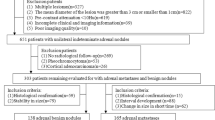Abstract
Purpose
The aim of this study was to assess the diagnostic efficacy of PET/CT using various parameters for the characterization of adrenal nodules in lung cancer patients.
Methods
Sixty-one adrenal nodules in 51 lung cancer patients were evaluated. The final diagnosis was based on histology (n = 2) or imaging follow-up (n = 59, range of follow-up: 7–57 months, median 27 months). Each adrenal nodule was analyzed using four parameters of PET/CT: the maximum standardized uptake value (SUVmax), the adrenal nodule/liver ratio of the SUV (SUV ratio), Hounsfield units (HU) and size. The optimal cutoff of each parameter for the identification of metastatic nodule was determined by ROC analysis and then the diagnostic efficacy was compared among the parameters.
Results
Of the 61 adrenal nodules, 45 (73%) were considered metastasis. The optimal cutoff values of the parameters were SUVmax >2.7, SUV ratio >1.3, HU >18 and size >20 mm, respectively. The sensitivity, specificity and accuracy by SUVmax >2.7 were 88.9%, 87.5% and 88.5%, and those by SUV ratio >1.3 were 84.4%, 100% and 88.5%, respectively. The combination of SUV ratio >1.3 and HU >18 had sensitivity of 97.7%, specificity of 81.2% and accuracy of 93.4% to predict adrenal metastasis in patients with lung cancer.
Conclusion
SUV ratio from F-18 FDG PET/CT could identify the adrenal metastasis in lung cancer patients. The combination of SUV ratio and HU can improve the accuracy of differentiating benign and metastatic adrenal lesions in lung cancer patients.



Similar content being viewed by others
References
Kloos RT, Gross MD, Francis IR, Korobkin M, Shaprio B. Incidentally discovered adrenal masses. Endocr Rev. 1995;16:460–84.
Mansmann G, Lau J, Balk E, Rothberg M, Miyachi Y, Bornstein SR. The clinically inapparent adrenal mass: update in diagnosis and management. Endocr Rev. 2004;25:309–40.
Abrams HL, Siro R, Goldstein N. Metastases in carcinoma: analysis of 1, 000 autopsied cases. Cancer. 1950;3:74–85.
Mody MK, Kazerooni EA, Korobkin M. Percutaneous CT-guided biopsy of adrenal masses: immediate and delayed complications. J Comput Assist Tomogr. 1995;19:434–9.
Boland GW, Lee MJ, Gazelle GS, Halpern EF, McNicholas MM, Mueller PR. Characterization of adrenal masses using unenhanced CT: an analysis of the CT literature. AJR Am J Roentgenol. 1998;171:201–4.
Lee MJ, Hahn PF, Papanicolaou N, Egglin TK, Saini S, Mueller PR, et al. Benign and malignant adrenal masses: CT distinction with attenuation coefficients, size, and observer analysis. Radiology. 1991;179:415–8.
Korobkin M, Giordano T, Brodeur F, Francis IR, Siegelman ES, Quint LE, et al. Adrenal adenomas: relationship between histologic lipid and CT and MR findings. Radiology. 1996;200:743–7.
Haider MA, Ghai S, Jhaveri K, Lockwood G. Chemical shift MR imaging of hyperattenuating (>10 HU) adrenal masses: does it still have a role? Radiology. 2004;231:711–6.
Reinig JW, Doppman JL, Dwyer AJ, Frank J. MRI of indeterminate adrenal masses. AJR Am J Roentgenol. 1986;147:493–6.
Kumar R, Xiu Y, Yu JQ, Takalkar A, El-Haddad G, Potenta S, et al. 18F-FDG PET in evaluation of adrenal lesions in patients with lung cancer. J Nucl Med. 2004;45:2058–62.
Erasmus JJ, Patz Jr EF, McAdams HP, Murray JG, Herndon J, Coleman RE, et al. Evaluation of adrenal masses in patients with bronchogenic carcinoma using 18F-fluorodeoxyglucose positron emission tomography. AJR Am J Roentgenol. 1997;168:1357–60.
Gupta NC, Graeber GM, Tamim WJ, Rogers JS, Irisari L, Bishop HA. Clinical utility of PET-FDG imaging in differentiation of benign from malignant adrenal masses in lung cancer. Clin Lung Cancer. 2001;3:59–64.
Sung YM, Lee KS, Kim BT, Choi JY, Chung MJ, Shim YM, et al. 18F- FDG PET versus 18F- FDG PET/CT for adrenal gland lesions characterization: a comparison of diagnostic efficacy in lung cancer patients. Korean J Radiol. 2008;9:19–28.
Brady MJ, Thomas K, Wong TZ, Franklin KM, Ho LM, Paulson EK. Adrenal nodules at FDG PET/CT in patients known to have or suspected of having lung cancer: a proposal for an efficient diagnostic algorithm. Radiology. 2009;250:523–30.
Na II, Cheon GJ, Choe DH, Byun BH, Kang HJ, Koh JS, et al. Clinical significance of (18)F-FDG uptake by N2 lymph nodes in patients with resected stage IIIA N2 non-small-cell lung cancer: a retrospective study. Lung Cancer. 2008;60:69–74.
Kocijancic I, Vidmar K, Zwitter M, Snoj M. The significance of adrenal metastases from lung carcinoma. Eur J Surg Oncol. 2003;29:87–8.
Luketich JD, Burt ME. Does resection of adrenal metastases from non small cell lung cancer improve survival? Ann Thorac Surg. 1996;62:1614–6.
Porte H, Siat J, Guibert B, Lepimpec-Barthes F, Jancovici R, Bernard A, et al. Resection of adrenal metastases from non-small cell lung cancer: a multicenter study. Ann Thorac Surg. 2001;71:981–5.
Cirillo Jr RL, Bennett WF, Vitellas KM, Poulos AG, Bova JG. Pathology of the adrenal gland: imaging features. AJR Am J Roentgenol. 1998;170:429–35.
Caoili EM, Korobkin M, Francis IR, Cohan RH, Dunnick NR. Delayed enhanced CT of lipid-poor adrenal adenomas. AJR Am J Roentgenol. 2000;175:1411–5.
Pena CS, Boland GW, Hahn PF, Lee MJ, Mueller PR. Characterization of indeterminate (lipid-poor) adrenal masses: use of washout characteristics at contrast-enhanced CT. Radiology. 2000;217:798–802.
Blake MA, Slattery JM, Kalra MK, Halpern EF, Fischman AJ, Mueller PR, et al. Adrenal lesions: characterization with fused PET/CT image in patients with proved or suspected malignancy—initial experience. Radiology. 2006;238:970–7.
Metser U, Miller E, Lerman H, Lievshitz G, Avital S, Even-Sapir E. 18F-FDG PET/CT in the evaluation of adrenal masses. J Nucl Med. 2006;47:32–7.
Park BK, Kim CK, Kim B, Choi JY. Comparison of delayed enhanced CT and 18F-FDG PET/CT in the evaluation of adrenal masses in oncology patients. J Comput Assist Tomogr. 2007;31:550–6.
Yun M, Kim W, Alnafisi N, Lacorte L, Jang S, Alavi A. 18F-FDG PET in characterizing adrenal lesions detected on CT or MRI. J Nucl Med. 2001;42:1795–9.
Author information
Authors and Affiliations
Corresponding author
Rights and permissions
About this article
Cite this article
Cho, A.R., Lim, I., Na, I.I. et al. Evaluation of Adrenal Masses in Lung Cancer Patients Using F-18 FDG PET/CT. Nucl Med Mol Imaging 45, 52–58 (2011). https://doi.org/10.1007/s13139-010-0064-6
Received:
Accepted:
Published:
Issue Date:
DOI: https://doi.org/10.1007/s13139-010-0064-6




